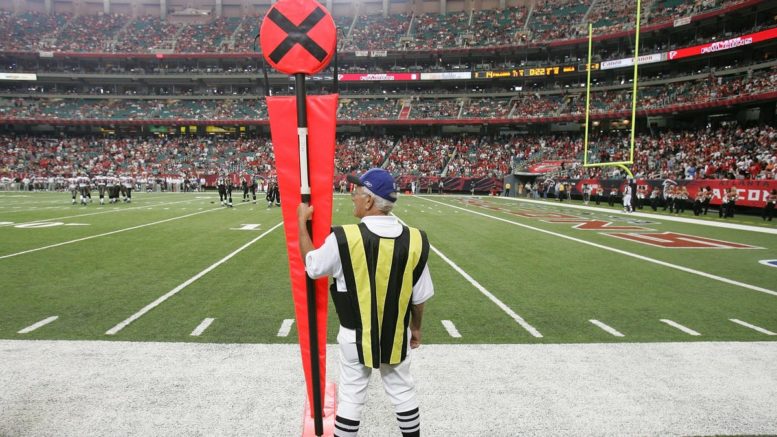College football might follow in the footsteps of the NFL as the NFL mulls taking a page out from soccer. After the Michigan sign-stealing scandal, in-helmet communicators could be coming to FBS programs, as well as a two-minute timeout. The Shield meanwhile might eschew the chain gang for optical tracking technology and more accurately spot the ball after downs.
I’m all for quickening the pace of play, though I’d argue that reviews and commercials are the true time suck, but that’s neither here nor there. This is about how the proposed changes could affect each sport. So I’m going to do a little advocate-devil’s advocate with these ideas to suss out the pros and cons. Obviously, I’m not making the final call, so who cares, but the NCAA and NFL love to self congratulate after making changes like this and overlook all the hypocrisy, stupidity, etc.
Robot chain gangs: Advocate
If Mike Tirico and Cris Collinsworth can spot the ball quicker and more efficiently in between guffawing than the zebras can from the sideline, something is wrong. Too often botched spots go unchallenged because no one is going to waste a red flag over a half a yard here or there. Seemingly innocuous errors after first and second down can be the difference between what you call on third down.
This also theoretically would do away with measurements, which have been a way for coaches to get an unofficial timeout for decades. Now that certain plays are reviewed and challenges can come from the booth, there’s plenty of free timeouts. However, these geniuses of clock management might have less time to screw up crucial short-yardage situations. That’s fun, right?
Oh, and those instances when we can see a player’s knee hit the ground but not where the ball is? Now we would know. The league says it’s still two years away from implementing this in games, so they’ve got some time to figure out how to employ the tech, and presumably who to employ to operate it.
Robot chain gangs: Devil’s advocate
In the grand scheme of this billion dollar sport, paying chain-gang members $75 to $100 per game is nothing. The NFL has this fancy technology and simply wants to shove it down our throats so they can license the optical tracking tech to Microsoft or whoever makes the tablets that QB’s snap after bad interceptions. This is another instance of AI replacing a perfectly idle human.
What’s more dramatic than a measurement after a fourth-down stand? The cameras zoom in, the ball is short by a couple of links, the crowd erupts, and the defenses hops off the field. It’s theatrics for the sake of entertainment, and isn’t the NFL in the entertainment business?
The league seems to enjoy a referee controversy as much as anyone, and now they want to strip it away in the name of integrity? OK. I also have a question about when we can see where the ball is but not when the knee touches. What’s the plan in that instance, Roger?
And unlike in soccer with only a handful of offsides calls over the course of 90 minutes, how much is this tool going to be needed? Is there going to be a designated referee upstairs to monitor the spots and relay them to the field after every down? These guys can barely finish a review during a 90-second commercial break.
Helmet communicators and two-minute timeouts: Advocate
That it took a sign-stealing scandal in 2023 to force communicators into the helmets of QBs and linebackers is absurd. This should’ve happened a long time ago because the honor system doesn’t work with millions of dollars on the line. Once the Houston Astros got nabbed in MLB last decade, the NCAA should’ve found the money to take care of it.
Louisville tried it out during its bowl game and predictably loved it. If approved, both changes would go into effect in the fall.
So, no more stupid signs or sideline choreography, and thank god, because nothing is more tired than an assistant coach holding up a poster board of memes. We get it, you can add funny images to your play calls. Not anymore, so go find your puff piece elsewhere, Gene Wojciechowski.
As for the two-minute timeout, I always thought it was weird that the NFL had it but not college. It seems like sort of training wheel for coaches, which the majority of college coaches need. Add this to the helmet radios and game management just got a lot easier. Play calls can come in without having to decipher a billboard, so that should save a timeout or two. Plus, they just got an extra one.
Will Dabo Swinney still stare at the game clock like it’s a physics problem late in the fourth? Probably, so win-win.
Helmet communicators and two-minute timeouts: Devil’s advocate
There’s not much to nitpick with helmet radios. Only two players per team get them, and something tells me that expense will get top priority. It’s just another example of the NCAA’s superfluous rules and claims from lesser programs that they can’t afford jockstraps. If Jimbo Fisher can get a $75 million buyout and locker rooms double as arcades, there’s enough money for all 22 starters to get a fancy headset.
Glad you could find it in the budget. If not, just raise tuition or ticket prices. Simple.
The addition of two extra timeouts is a direct response to the clock-stoppage rules that went in place a year ago and sped up contests too much for sponsors. This way, those time slots can go back to the traditional three-and-a-half hour window with ease. How can Dr. Pepper justify spending millions and only run 22 ads per game instead of 25? Won’t somebody please think of the inner mechanisms of late-stage capitalism?!
Original source here
#pros #cons #proposed #advancements #NFL #college #football





